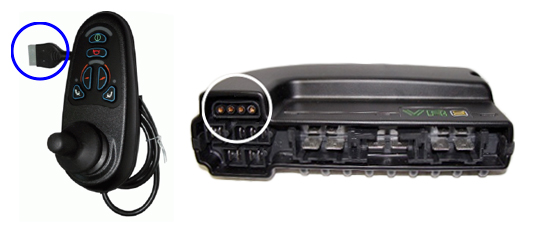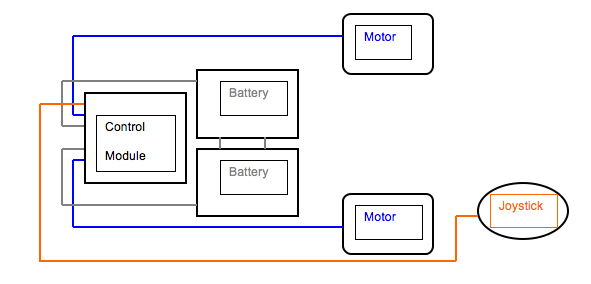Share:
Hello all!
As I stated in last month's article, in continuing to "de-mystify" power wheelchairs, we will look at how the controller, or control module, works to provide instructions to the motors to move the power wheelchair in the desired manner.
The electronics are the "brains" behind the power wheelchair and include the input device, such as the joystick, and the control module, or controller. Below are pictures of a standard joystick (pictured left) and a control module (pictured right). Note that the term "joystick" actually refers to the whole unit, as pictured, and this includes the joystick handle or knob. A stick handle is pictured below. The handle can easily be pulled off the joystick gimbal to be replaced with other handles, such as a ball, T-handle, or goal-post.

The four-pin connector on the joystick (at the end of the long cable) plugs into the four-pin slot at the upper-left corner of the controller to connect the two. You will notice that there are other slots available on the controller. Among other things, there are slots to connect the two motors and the power (i.e. the batteries).
A simplified way to think about how everything connects to the control module is set out in the schematic diagram below. (Note that the diagram is not to scale and the lines do not represent colours for electrical wiring or actual placement position in the controller.)

When the motors, batteries, and joystick are connected into the controller, a deflection of the joystick handle sends a signal to the control module, which gets translated into current and voltage energy to send to the motors, which in turn, depending upon the motors, draws energy from the battery. If the joystick handle is deflected forward, this means that the controller signals to provide the same amount of energy to both motors to move the wheelchair in a straight line forwards. If the gimble is deflected to the left to turn the wheelchair in a leftward direction, more energy will be directed to the right motor to allow the right side of the wheelchair to move towards the left while the left side of the wheelchair remains stationary during the turn (depending upon the degree of deflection to the left).
As I said earlier, the controller is the "brains" of the power wheelchair. Essentially, the control module has a micro-processor with electronic storage, which is what allows it to be programmed with various parameters. (Please refer to the article on Power Programming Basics for a review of the common adjustments that can be made to the programming of a power wheelchair.) When changes are made to the programming, this information is stored in the controller. The controller then only allows the wheelchair to operate within the set parameters. If, for example, forward maximum speed is programmed to be 70 per cent of the maximum speed available, the controller "remembers" this so that when the gimble is fully deflected, the controller allows the motors to draw energy sufficient to achieve only 70 per cent of the maximum speed available.
By understanding the controller, or the "brains" of the power wheelchair, we can start to de-mystify the power wheelchair and see how the controller, joystick, motors and batteries work together to produce the desired movement specified through the input device, or joystick handle. There is still so much more to know about power wheelchairs and electronics. Stay tuned for future articles!